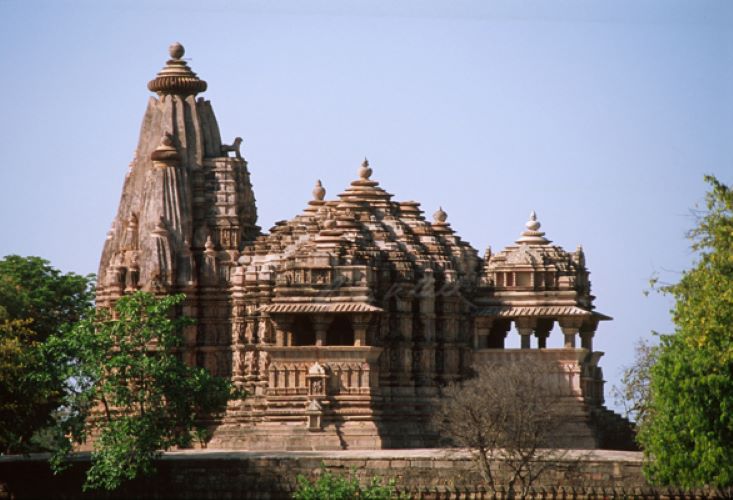THE TEMPLE COSMOS

Kandariya Mahadeva Temple, Khajuraho, Madhya Pradesh
Benoy K Behl
The Indian temple is conceived as a place for the self-transformation of the devotee. A place where the noise and confusion of the material world are left behind. Where in the sanctified silence, one may gain the knowledge of the oneness of all of creation.
The temple and the sculpture upon it represent the cosmos and its eternal harmony. This is the theme which underlies early Indic religious traditions. The temple is conceived as the cosmos in miniature. The Brihatsamhita, written in the early 6th century, describes the centre of the sanctum as the place for Brahman, the formless divine which pervades all that there is. Around the shrine are made manifestations of the deity, in forms most closely associated with it.
The temple is a place where the cosmos is replicated and explained to the devotee: from the representation of the unmanifest eternal to the multitude of forms of the world. As time progressed, the temple became more grand and complex in its depiction of this theme. The abundance of life and the depiction of innumerable creatures of the world thickly covered the walls of the temple.
A tower was made over the sanctum of the deity. As the number of people who visited the temple grew in size, and as provisions needed to be made for gatherings on festive occasions, a hall or mandapa was constructed before the sanctum. Both the tower and the hall developed different shapes in North and South India. In North India, a curvilinear tower in the style termed Nagara was developed.
The central buttresses of the walls of the temple hold the images which are closest to the temple’s main deity. These represent an aspect of the deity in the sanctum. They make the deity who is deep inside visible on the outside.
It is through these that the formless eternal is given a personality and made more approachable for the devotee.
These images are placed in line with the garbha-griha or the sanctum sanctorum. They serve as windows for the deity to be manifest in the world outside. The image on the back wall of the temple is the one most closely related to the deity in the inner shrine. As most temples face east, the rear wall is normally the one facing west. In Shiva temples, it is his son Ganesha who appears on the south wall. Shiva’s wife Parvati, in her many forms, normally appears on the north wall.
These images are for personal devotion and are known as Ishta devatas. They relate to the world as known to the worshipper, through images of the family life of the deity. Yet, they take the devotee to another plane of reality, where the separated forms of the world begin to come together in the divine. The worshipper is provided a glimpse of the reality beyond the mundane world. He is slowly prepared for the great crossing, deep inside the temple, from the world of illusion to the knowledge of the oneness of it all.
The temple walls abound in images of the abundance and fruitfulness of nature. This is the world of forms, the manifestation in numberless parts, of the eternal truth of the garbha-griha. Nagas, divine serpent kings, embody the protective forces and harmony of the world. Leogryphs rear upon the walls, awakening the courage within us, to face the inner truth.
Continuing the tradition of yakshis of ancient times, are celestial apsaras and languorous Kanyas, beautiful women.
The doorway of the shrine is given special importance. For it is here that we leave behind the noise and confusion of the world to enter the peace of the cosmic order. The two great rivers which water north India- Ganga and Yamuna, bless us with their treasure of fertility, at the doorway.
Lakshmi, the deity of abundance, has been present from early times in shrines of all religions.
The icons presented in the temple were developed in the religious texts called the Puranas, literally meaning ‘ancient’. The Agamas are texts which contain the essential attributes of the deities for their representation in the sacred art of the temple.
Under its series Glimpses Of Culture, India Habitat Centre is presenting a talk by
Art Historian, Film-maker & Photographer (and the author of this article) Benoy K Behl
today (June 22) at 6pm. A film ‘The Temple Cosmos’ ’ (produced by Behl for Doordarshan)
will also be screened on the occasion. Click here to join

